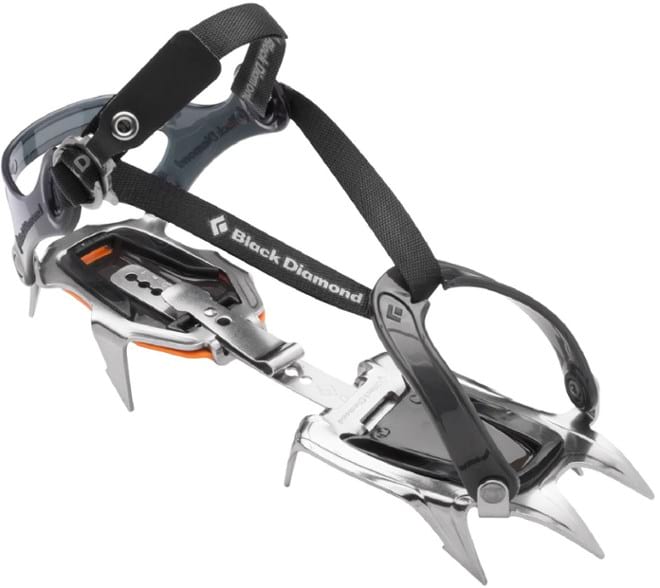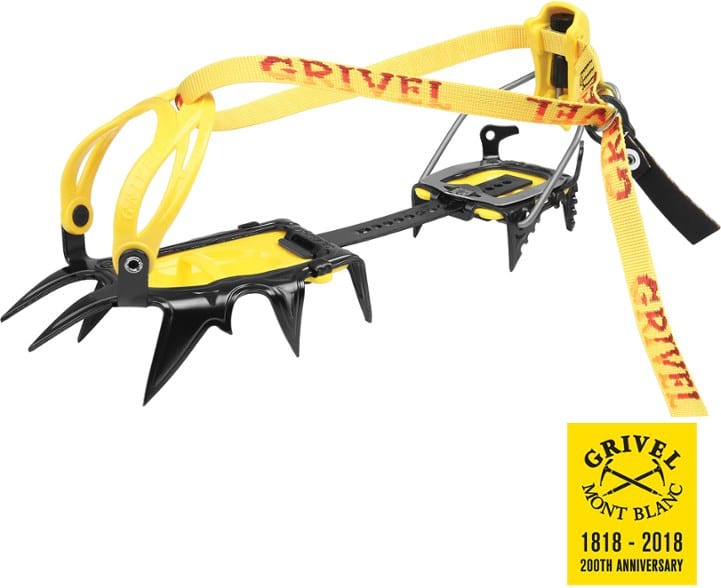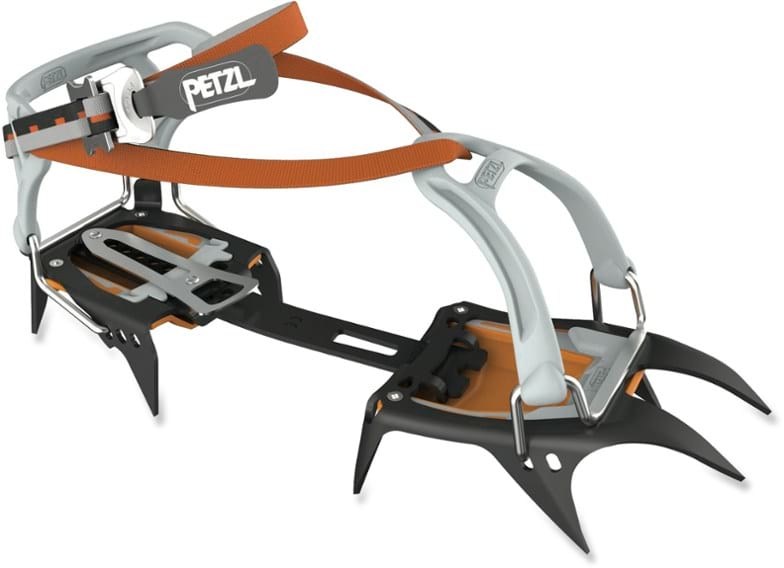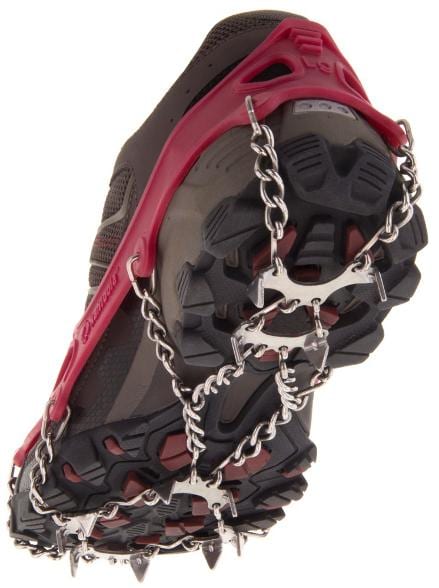Whether you’re planning a hike on a snowy trail or you’re taking on an icy climb up a snow-covered mountain, having the right equipment is crucial for safety.
It’s very easy to slip when hiking through snow, and the last thing you want is an injury when you’re miles away on a hiking trip.
That’s where microspikes and crampons come in. Both are traction footwear that help you traverse slippery and snow-covered uneven terrain more safely and easily.
If you’ve come across microspikes and crampons during your research, you might think they’re the same thing. But these are actually two very different types of footwear for totally different purposes.
If you need equipment for hiking, running, or climbing through icy conditions and deep snow, this post will show you whether you need microspikes or crampons for the trip.
Microspikes
Microspikes are just shorter spikes and metal chains worn over trekking footwear to give excellent traction on frozen trails. They’re used by backpackers, hikers, and climbers and give much more grip than standard winter hiking boots. So whether you’re solo trekking through Nepal or taking on the Big Pine Lakes Trail, these are a good piece of gear to have.
Where do you use Microspikes?
Microspikes are worn on mostly level winter trails that are covered in snow conditions. They give much more solid traction than boots, but aren’t as useful for steep climbs.
What are Microspikes made of?
A pair of microspikes are made out of stainless steel spikes that have good corrosion resistance and are highly durable for the cold temperatures you’ll use them in. The spikes are held together by stainless steel chains that fit around your boot, also giving additional traction on compacted snow while keeping the microspikes secure.
Crampons

Crampons are a lot like microspikes but are larger and more for mountaineering than simple hiking. Most require mountaineering boots with welts to be attached to, rather than standard hiking shoes, since they need stiff shanks to remain secure.
Where do you use Crampons?
Technical crampons were actually designed for ice-climbing, which is why they have a larger crampon spike on the front and underneath for getting a better grip through ice. They are best used when traversing glaciers, snow slopes, an icy trail, and snowfields.
Icy treks in the winter like backpacking through Channel Island National Park or taking on one of the famous peaks will almost definitely require crampons.
What are Crampons made of?
Crampons are usually either made of steel or aluminum. Stainless steel frames are heavier but more durable and corrosion resistant, making them best for harsh conditions. Aluminum crampons are a lightweight option which is much more suited to alpine climbs like Boulder Chain Lakes, but they are going to wear out with time.
Crampons vs Microspikes: How to Choose
Now you know what microspikes and crampons are, it’s important to know the key differences so you can choose which is best for your hiking or mountaineering trip.
There are several key differences you need to take into account when making your choice.
Design
Although crampons and microspikes look similar, they actually have a different design. Crampons have large, one-inch spikes for embedding deeper into snow and ice. Whereas microspikes have smaller, quarter- or ½ inch spikes for getting better grip in the snow.
Microspikes also have chains holding them together to enhance traction in the snow. Mountaineering crampons don’t have this, instead, they have thick straps with spaced out spikes which are more suited to slopes and aid technical climbing.
Usage
You’ll struggle to trek with a traditional crampon, but they will help massively with climbing and traversing slopes. On the other hand, microspikes are great for hiking, but are pretty useless for climbing or steeper terrain. This is because microspikes are much lighter and comfortable to wear.
Overall, microspikes are easier to use, whereas pairs of crampons require some degree of training to use safely. If you’re a total beginner, hiking crampons are probably not the right option for you unless you’re planning a climb with an experienced mountaineer who can show you the ropes.
Price
Crampons are significantly more expensive than microspikes since they’re a specialist piece of equipment. Having said that, you should buy microspikes just because they’re a cheaper option.
The ultimate decision of which are best for you comes down to your activity:
- Hiking through snow on flat terrain: microspikes
- Climbing through snow on rocky terrain, mountains, or a steep slope: crampons
Our Favorites
Now you know which traction devices you need for your next adventure, let’s look at some of our favorite crampons and microspikes on the market so you know you’re getting the best quality equipment.
Our Favorite Crampons
Black Diamond Contact Strap Crampons with ABS Plates

- Price: $129.95
- Material: Stainless steel
Made from stainless steel, the Black Diamond Crampons won’t rust and always resist snowballing. Although they’re made from steel, they’re surprisingly lightweight and the low profile gives a much more secure connection compared to regular hiking boots.
They feature horizontal front points for better stability on snow, as well as secondary points and serrated points for biting into snow and ice while kicking steps.
The ABS plates stop snow sticking to the bottom of your feet and the flexible strap allows these to fit most snow boots.
With a simple but effective design, it’s easy to see why the Black Diamond Crampons are a popular choice for mountaineering.
Grivel G-12 New-Matic Crampons

- Price: $179.95
- Material: Chromoly steel
Chromoly steel is stronger than stainless and more flexible, so is a popular choice in sporting gear. It’s just as durable and resistant too, hence the higher price point.
The Grivel G-12 Crampons have latex sheets on the bottom to stop snow sticking, and the straps are incredibly easy to secure and adjust without the need for tools.
These crampons are popular with avid mountaineers since they’re lightweight but have large welts at the toes for the harder climbs.
Petzl Irvis Flexlock Crampons

- Price: $139.95
- Material: Steel
If you want lightweight, compact crampons that take up less room in your kit, the Petzl Irvis Flexlock are the ones for you. These feature a much thinner frame for reduced weight and are compact for easier transport.
Made from regular steel, these are more prone to corrosion, but they have two wide front points to give secure purchase in snow and ice, as well as a solid second row of teeth for support when front-pointing.
These also have an anti-snow system on the bottom to stop build up, as well as two extra teeth at the back for stability when descending downhill.
Our Favorite Microspikes
Kahtoola MICROspikes Traction System

- Price: $69.95
- Material: Elastomer/stainless steel
The Kahtoola Microspikes made it into the Backpacker magazine Gear Hall of Fame in 2017 so you know you’re getting a quality pair of spikes.
Featuring 12 ⅜-inch stainless steel spikes per foot, these offer aggressive traction for icy terrain. Each of the eyelets is also reinforced for added durability.
The harness is lightweight compared to previous versions, and stays flexible well below freezing, so won’t seize up on snowy hikes.
For the price point, these are a popular and award-winning pair of Kahtoola microspikes, and some of the best for hikes through snow.
Kahtoola EXOspikes Traction System

- Price: $59.95
- Material: Aluminum
If you’re looking for something a little cheaper but still durable, the Kahtoola EXOspikes are a good option. Made to take a beating, the TPUTraction Matrix is more durable than steel and is much more lightweight too.
A cross between nanospikes and microspikes, the EXOspikes have a secure fit and extra grip on uneven surfaces with a good bite into ice and packed snow.
The elastomer harness stays flexible up to -30°C and the raised heel tabs make them easy to take on and off.
Overall, these Kahtoola microspikes are great for hikes and treks on snow-covered terrain and can stand up to ice as needed.
Kahtoola NANOspikes Traction System

- Price: $49.95
- Material: Tungsten
The Kahtoola NANOspikes are actually much smaller than microspikes, with ten, 0.21-inch spikes made from tungsten carbide. Tungsten isn’t as durable as stainless steel, but it’s a great budget option at an affordable price for beginners.
The tungsten spikes are surrounded by shock-absorbing cleats which make these a great choice for running or walking on slippery surfaces. However, if you’re planning a hike through snowy terrain, these won’t give the same traction on ice as the other options.
They do have quick release tabs to get them on and off easily, and the elastomer harness keeps them secure and flexible while in use.
Conclusion
If you’re a beginner to hiking or mountaineering, trail crampons and microspikes do look like the same piece of gear. However, they are very different and need to be used in completely different scenarios.
When It comes to choosing between the two, assessing the terrain you’ll be covering is key. And if your adventure involves both flat hiking and traversing snowy peaks, your best bet is to pack both.
Whatever you decide, having the right equipment will make your trip not only much easier, but much safer. So take your time when choosing between crampons and microspikes!

